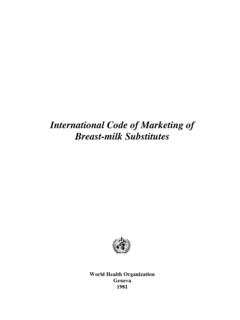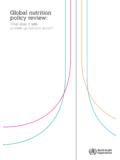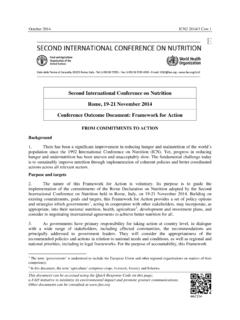Transcription of Thailand - Food and Nutrition Security Profiles
1 Thailand - Food and Nutrition Security Profiles Key Indicators Thailand has an integrated framework for food and Nutrition Security , with a National Food Safety and Nutrition plan. The country has experienced rapid growth in per- capita GDP and Dietary Energy Supply (DES), as well as a sustained decline in undernourishment rates. Thailand displays a declining trend of nutritional outcomes, particularly in underweight and stunting. Nevertheless, an emerging issue is that of overweight, both for one-third of the adult population and for children. Anaemia and Vitamin A deficiencies continue to be matters of public health concern. The International Code of Marketing of Breastmilk Substitutes is being implemented. Figure Food Figure Undernourishment and Economic Growth Figure Child Mortality From 1990 to 2010: Availability From 1990 to 2012: Under-5 mortality reduced 65% and is set to achieve From 1990 to 2011: GDP increased 113% the Millennium Development Goal (MDG) target DES increased 33% Undernourishment declined by 87%.
2 Infant mortality reduced 63%. Animal-origin supply increased 47% GDP per person, PPP (constant 2011 dollars) Neonatal mortality reduced 58%. Vegetal-origin products Undernourished in total population increased 31% and International $ Percent remained the major DES 15000 50 MDG. source Target 3000 14000 13586 45 13. 13000 40. 2757 12000 35 11000 30 2500 347 10000 25. 9000. 1990. 1995. 2000. 2005. 2010. 2012. 2015. 2069. 20. 8000 Infant Neonatal Under fives 236 7000 15 Source: Inter-agency Group for CME (2013). 2000. 6000 6369 10. Figure Anaemia 5000 5 Anaemia is a public health issue for pregnant women (22%), non-pregnant women (18%) and under-5. Kcal per person per day 1990. 1992. 1994. 1996. 1998. 2000. 2002. 2004. 2006. 2008. 2010. 2012. children alike (25%). 1500. Source: GDP: WDI 2014 / Undernourished: FAO SOFI_2013. Total <2 yr Figure Child Malnutrition From 1993 to 2012: 2410.
3 Stunting declined 23% Children <5 years 25. Underweight declined 44%. 1000. Wasting stood at 7% in 2012 Non - pregnant women 1833 Overweight increased 132% in 18 years 18. of reproductive age Overweight Stunting Pregnant women 22. 21. Underweight Wasting 500 0 20 40 60 80 100. 18. Prevalence of Anaemia (%). 16 Source: WHO Worldwide prevalence of Anaemia (1993-2005). 16. 15. Anthropometry (Table ). 0. 11 Underweight women (BMI < 1990 2011 % 2004. 8 9 kg/m2). Vegetal Origin 7 Overweight adults (BMI >= 25 kg/m2) % 2003. 5 7. Animal Origin * BMI values calculated using adult cut off points, population < 20 should be analyzed using WHO growth reference for school aged children and adolescents Total Dietary Energy Supply (DES) Proportion of infants with low birth % 2012. 1993. 1995. 2006. 2012. weight Source : FAOSTAT FBS: 2014 update Source: Thailand MICS 2012 Source: MICS 2012 /UN_WHO Global Database on BMI_2013.
4 Thailand - Food and Nutrition Security Profiles Food Availability / Food Access Access to food Figure Economic access to food General and food inflation Percent General inflation Food inflation 14. 12. 10. 8. Food Availability 6. Figure Food supply by food group - 4 5. 2. (kcal/person/year) Total dietary energy supply= 2,757 (2011). 0. 0. 2011 1990. 2000. 2001. 2002. 2003. 2004. 2005. 2006. 2007. 2008. 2009. 2010. 2011. 2012. -2. Cereals 1285. 1080. Rice 1109. 1036 Source: ILOSTAT Database Consumer Price Indices 2014. Wheat 83 In 2008, during the global food crisis, food prices increased significantly 41. more than general prices and continued that trend through 2012. 276. Meat & Milk & Eggs In 2011: 181. Families generally spent more than 23% of their income on food Sugars and syrups 395. 177 While cereals contributed 47% of food intake, they only affected 4% of 147.
5 Food expenditure at household level Fruits & vegetables 191. Vegetable oils 283. 112. Fish & Fish products 52. 39. Animal fats 18. 15. 33. Figure Share of food expenditure (2011). Pulses 21. 100. Starchy roots 62 Non food items 33. 0 400 800 1,200 1,600. Cereals Source: UN_FAO Food Balance Sheets_2014 Update 80 47. Fruits and Cereals remain the most important source of food energy, and vegetables Percent contribute to 52% of food intake, with rice representing 90% of 60 77 Fish these cereals Sugars and Syrups (123%) and vegetable Oils (153%) have 3. 3. increased considerably and are significant contributors to DES Sugars 2. 6. 40. Veg oils 16. 20 4 Meat, milk and 3 eggs 0 2 0 25. 5. Other 8. 0. % Total expenditure per person % Dietry energy Consumption per day Sources: UN_FAO RAP based on national HIES, ECS, SES, HLSS_2013 Update, Thailand Thailand - Food and Nutrition Security Profiles Food Utilization Food utilization refers both to household preparation practices of foods, which influence nutrient content of consumed foods, and to the absorption of nutrients by the human body after consumption.
6 Nutrient absorption in the gut is strongly influenced by health status, particularly the presence of diarrhoea. Hygienic environmental conditions related to improved water and sanitation are important determinants of health and infection incidence and prevalence. In Thailand , improved water and sanitation conditions have been achieved during the past 20 years. Water and Sanitation Figure Access to Improved Sanitation Figure Open Defecation Figure Access to Improved Water Sources From 1990 to 2012: From 1990 to 2012: From 1990 to 2012: Access to improved sanitation increased 14% No longer a development issue Disparities between urban and rural areas in in 22 years access to improved water sources have Disparities between rural and urban areas essentially been solved have been reversed; access is more frequent in At least 96% of people have sustainable rural than in urban areas access to improved water 11% of houses in urban areas do not have 97.
7 Proper sanitation 100 96 96. 100. 86. 95. 100 96 80 80 82. 87. % Population % Population % Population 80 93. 82 60 60. 89. 80. 60. 40 40. 40. 20 12 20. 20 0. 00. 0 0 0. 1990. 1993. 1996. 1999. 2002. 2005. 2008. 2011. 1990. 1993. 1996. 1999. 2002. 2005. 2008. 2011. 1990. 1993. 1996. 1999. 2002. 2005. 2008. 2011. Total Rural Urban Total Rural Urban Total Rural Urban Source: WHO-UNICEF Joint Monitoring Programme, 2014 Source: WHO-UNICEF Joint Monitoring Programme, 2014 Source: WHO-UNICEF Joint Monitoring Programme, 2014. Food Safety Quality and food safety efforts cover the entire complex chain of agriculture production, processing, transport, food production and consumption. Figure Diarrhoea Management of Diarrhoea (Table ). Diarrhoea in young children is not a public health concern in any of the wealth quintiles. 20. 15. Zinc Percent 10 Share of children under age 5 with diarrhoea receiving zinc - treatment 5 Existing policy framework Zinc Supplementation and Reformulated Oral Rehydration Salt in the 0 Management of Diarrhea Lowest Second Middle Fourth Highest Source: THA_MICS 2012 Wealth quintile Source: Thailand - Food and Nutrition Security Profiles Food Utilization Nutrition and Health Figure Exclusive Breastfeeding Figure Complementary Feeding Early initiation of breastfeeding is correlated with lower infant mortality Introduction of complementary feeding is timely for 3 out of 4.
8 And relatively prolonged breastfeeding. It has decreased to 46% in 2012 children from 50% in 2005. (Remained far from optimal) Minimum meal freqeuncy is also met by 78% of children Exclusive breastfeeding was only 12% in 2012, avery poor situaton 100 Introduction of solid, semi-solid or soft 75. food Early initiation of breastfeeding 80. Minimum dietary diversity 60 50 46. Percent 40. Minimum meal frequency 78. 20 15 0 Minimum acceptable diet 2005-2006 2009 2012. Percent Source: Thailand MICS 2012 Source: THA_MICS 2012 0 20 40 60 80 100. Figure Duration of Breastfeeding No Data Figure Child Malnutrition and Poverty Micronutrient Status Underweight is 4 times more frequent in the lower wealth quintile than in Figure Vitamin A. the higher, and stunting is more than double in the poorere quintile tahn in Vitamin A deficiencies (16% of pre-schoolers) indicate that Vitamin the richest ones.
9 A is still lacking in the daily diet, and that food-based interventions, Overweight is nearly double in the richest quintile compared to the poorest including food fortification, deserve on going attention. ones. 25 Overweight Stunting Underweight Wasting 100. Vitamin A Supplementation 20 75 Coverage - full children 6-59. months /a Percent 50. Vitamin A Deficiency 25. 15 (Pre-School Aged Children). 0 < /b 0. * VAD is a severe public health problem if >20% of preschool children (6-71. 10 10 months) have low serum retinol (< mol/L). Source: a/ UNICEF, State of the World's Children 2014, b/ WHO Global prevalence of vitamin A deficiency in population at risk 1995- 7 2005 report. 5 Iodine (Table ). Households consuming iodized salt (2012)/a %. Iodine deficiency (Urinary Iodine Concentration <100ug/L) among - school-age children 0.
10 *Optimal UIE 100 - 199ug/L. Lowest Second Middle Fourth Highest Source: Thailand MICS 2012 Source: a/ Thailand MICS 2012. Thailand - Food and Nutrition Security Profiles Policy Table - 1. Enabling environment for Nutrition and Food Security - Policy documents addressing Nutrition issues 1. Thailand Food Strategy 2010. Using a food-chain approach, the strategy addresses the continuum from agriculture to health 2. Thailand National Food Committee Act of 2008. Act covers food Security , food safety, food quality and food education: committee chaired by prime minister and meeting at least twice a year: 11 related ministries, 30 national agencies, 30 relevant Acts; developed and approved the Food Strategy 3. National Food and Nutrition Plan Formulated to guarantee Security and safety of food and Nutrition through the establishment of the national food safety system.


















